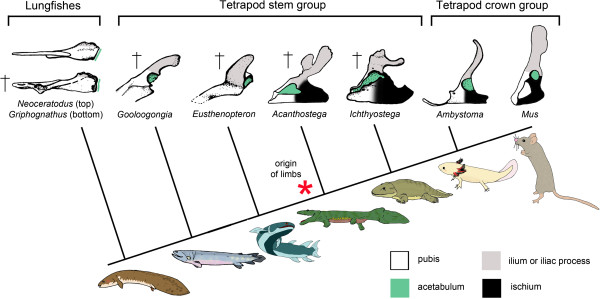Figure 1.

Phylogeny spanning the fish-tetrapod transition, showing stepwise transformation of the pelvic morphology. In lungfishes (Dipnoi) there is no iliac ramus, but a low ridge that can be homologized with the iliac process of other tetrapodomorph fishes. In the extant Neoceratodus the homologues of tetrapod iliac musculature attach to a low ridge anterodorsal to the acetabulum. In fish members of the tetrapod stem group (exemplified here by the rhizodont Gooloogongia and the osteolepiform Eusthenopteron), overall pelvic morphology is similar to that of lungfishes but an iliac process is present. In the stem tetrapods Acanthostega and Ichthyostega an ischium is present and overall pelvic morphology approaches that of extant salamanders such as Ambystoma. The boundary between ishium and pubis is approximate in stem tetrapods and axolotl as the elements are not separated by sutures. Anterior to the left. Phylogeny based on [4], Griphognathus and Neoceratodus redrawn from [15], Gooloogongia from [46], Eusthenopteron from [12], Acanthostega from [16], Ichthyostega from [17], Ambystoma from Figure 2, Mus musculus from [47]. All reconstructions by CAB.
